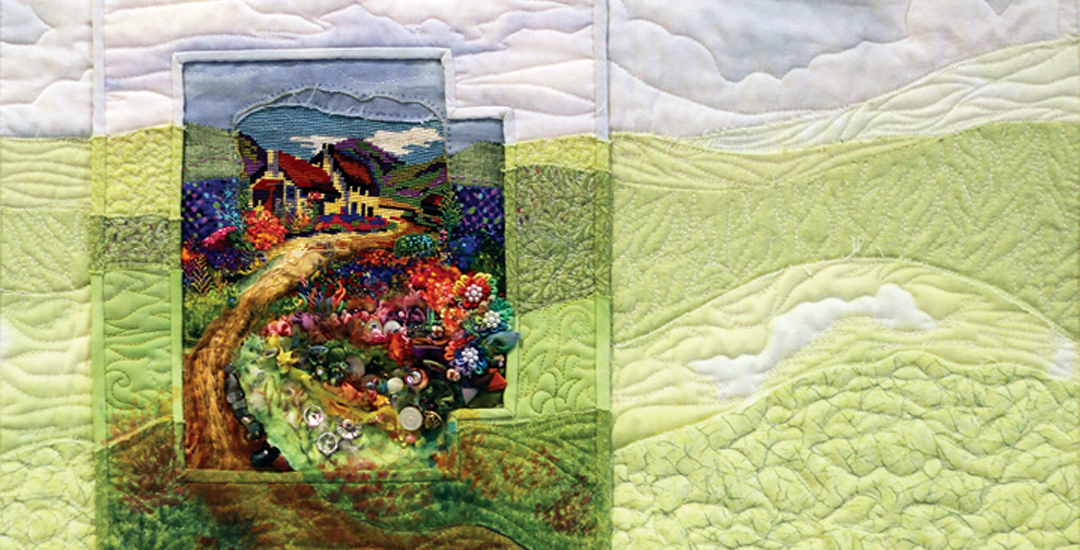In February, I was thrilled to share my collection of antique lace, sewing implements and quilts which contain either lace or intricate stitch work in an exhibition at the Art Gallery of Burlington. I am equally thrilled to share this experience with my Canadian quilting friends and kindred spirits in Canadian Quilter.

My journey of collecting began over 25 years ago, when my good friend, Lynn Anson-Cartwright, and I made a twice-per-year journey to The Lace Ladies of Greensville, a show hosted by owners of antique shops in Dundas, ON, which was held in a church hall over a long weekend. The ladies brought their finest wares from years gone by. Much to our dismay, the last event took place in 2017 – and I am sure to the dismay of a large contingent of collectors!
Like a moth to flame, each year my goal was to purchase the best quality, antique sewing implement I could afford, leaving myself latitude to discover beautiful treasures I had to have, such as silk threads, magnificent examples of Irish crochet lace or vintage scarves and jewellery.
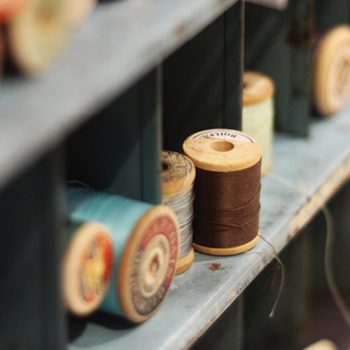
Twenty five years later, my collection includes two beautiful 1880 leather needle cases with leather sleeves filled with original needles, two antique 1865 ladies’ lace under sleeves and a collar and, best of all, many examples of fine lace. Over the years, the “Lace Ladies” saw my quilts and liked how I incorporated their treasures. They began saving me their choicest lace examples and I looked forward to visits with my kindred spirits.
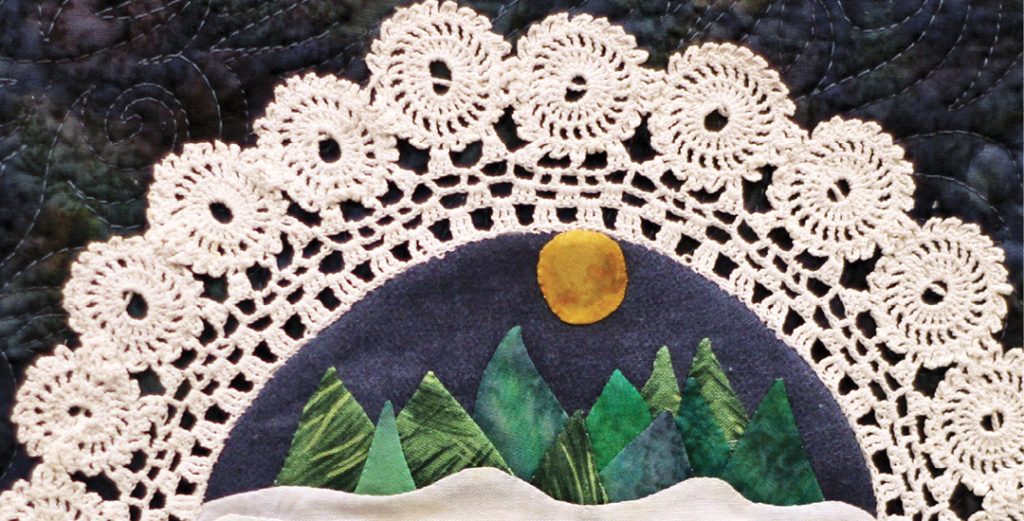
Incorporating the best examples of lace I could find seemed like a natural extension to my quilting. So many people comment about how I use lace doilies as snowflakes! I replace the centres of the doilies with small, winter vignettes, which are then hand appliquéd using silk to capture miniature scenes, complete with snowballs! Not many people realize it took almost ten years to find the exact sizes and shapes of doilies to finish that quilt! I am a patient person.
My recent exhibition not only included lace undersleeves, but an explanation and pictures of how I restored them to their original glory. During the process, the first decision was – what were they? Were the sleeves a Prop (a piece too far gone to restore, but a good example of the period), an Antique (an old piece I could date, with no provenance, no connection to an important historical figure) or an Artifact (an antique piece with provenance of historic significance)? These sleeves fit into the Antique category, but they were damaged. I found I had the correct colour and weight of thread to restore them, so next, I cut a 1.5-inch strip of cotton from the top of the sleeves to act as a new base layer. With the additional use of a medical magnifying glass with lights – I had the tools. The final and hardest decision – whether I could match the skill of the original lacemaker and whether I would do more harm than good. My years of working with fine sewing gave me guarded confidence. I swallowed hard and decided I would try.
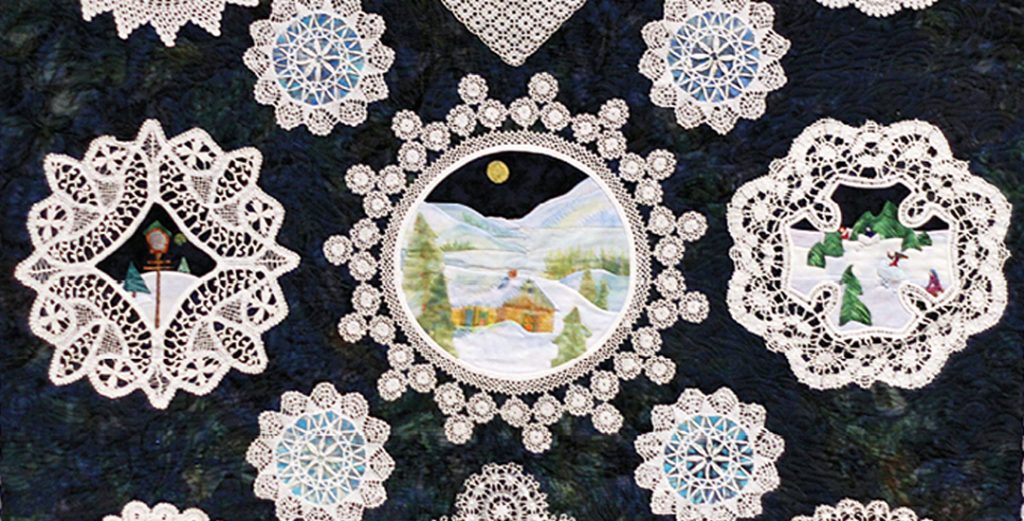
After a methodical review of the damage, including using photographs, I began. Weeks after undoing old repairs, using the cotton as a new base layer where time and wearing destroyed the original, the sleeves were finally done. It is amazing to me how much my quilting experience played a role in my ability to plan and execute this restoration. I used appliqué, reverse appliqué, prick stitching, back stitching and buttonhole stitching!
My friend, Lynn, collects antique plates and books. Her prizes from the “Lace Ladies” include a complete, 1865 Godey’s Lady’s Book bound edition, complete with all 12 colour plates. What a timeless treasure! Each monthly edition contained stories of romance, lessons on etiquette and deportment, household tips, patterns for clothes, hats, needlework patterns and fashions of the day.
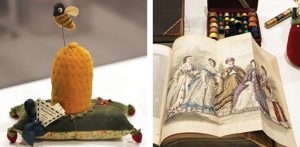
Equally stunning was an 1877 Peterson’s Magazine bound book edition and a 1920s DMC Embroidery Encyclopedia, all of which were leant to me for the exhibition. The DMC Embroidery Encyclopedia is a treasure trove of information about how to make all kinds of lace, as well as stitches. Although not as inspiring as my Judith Baker Montano books, with coloured pictures and finished projects, it is a wealth of knowledge not found in many places today.

The exhibition included my treasured heirloom quilts, a couture French Chantilly lace, Mother-of-the-bride dress Lynn and I created for her daughter’s wedding and some of my wild-and-crazy-side quilts, all with bits of lace and extensive embroidery stitch-work.
A realization hit me during the exhibition – every quilt includes something from those fantastic “Lace Ladies” of Greensville! The exhibition was a celebration of handwork—and a chance to pause and reflect about a slower-paced time when needle women were at the peak of their abilities during the 1700s and up to the mid-1800s. It was a time before the industrial revolution when bobbin-net machines changed the world. I am enjoying the needle books, sewing rolls and examples of lace in my collection.
I realized there was also a dark side to this exhibition, since many people went blind as they toiled on fine handwork, hour upon hour, in dim light. Many people had no choice but to give up their lives to embroidery and lace in order to eat and live. Today, we have many conveniences. At a time when life moves too fast and we have the luxury of great machines, it is a real privilege to discover and enjoy the journey of needle arts. Take time to learn and create – for your own pleasure. Wherever it takes you – my kindred spirits – the enjoyment will lead to treasured heirlooms for your families for many years to come!

